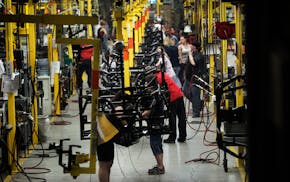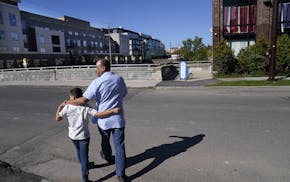Inflation grew just 1% in the Twin Cities in the past year as expenses — from housing to food to gas and utilities — have cooled more quickly here than nationwide.
It was the lowest year-over-year change the region has seen in three years. Across the country, the consumer price index climbed 3.2% in the past year, according to Bureau of Labor Statistics data though July.
The Twin Cities' low inflation rate through the past year continues to stand out from other metro areas.
"We're still well below any of our peers," Tyler Schipper, associate professor of economics at the University of St. Thomas, said of the annual data. "I don't see anything in these numbers that looks like it's going to usurp our position as the lowest inflation metro area in the country anytime soon."
However, inflation in the Twin Cities in the past couple of months has been middle of the pack compared with other metros, he added.
Jorge Deluciano, who was popping by Cub Foods in Minneapolis on Thursday to grab ingredients for a quick meal, said he was surprised that Twin Cities' inflation was lower than other metro areas.
"If it's lower than the rest of the country, what is it like in other places?" he asked. "Because it does feel like things are more expensive, for sure."
Minnesota's low consumer price index figure is due, in large part, to housing inflation here falling more quickly than many other places, Schipper said. The Twin Cities saw housing prices rise 2.3% in the past year compared with 6.2% nationally.
"We built so much multifamily housing, it allowed rental prices to come down here a little quicker," he said.
The state has drastically increased housing production in the past decade, with most of it being rental housing, said John Patterson, director of planning, research and evaluation at Minnesota Housing. Last year, production of rental units far exceeded what he predicted, and he said the state is close to the desirable 5% vacancy rate after years of it being much lower.
"Once you get to 5% vacancy rate, you pretty much have stable rental prices that rise roughly at the rate of inflation. That's why we're seeing a 2.3% increase in the rents," he said. But he noted the supply of single-family housing has still lagged demand, and the state still isn't producing enough affordable housing.
Meanwhile, energy prices in the Twin Cities fell 16.7% from last year. Gasoline and natural gas costs both plummeted. Those prices fell nationwide, but the annual drop has been sharper in the Twin Cities.
However, energy costs have ticked upward the past couple of months, with gas and other prices on the rise. Schipper predicted that gasoline prices will likely continue to rise slightly through the next month or so.
Recent rising gas prices have jumped out to Steph Wolf of St. Paul, who was filling her tank at a Holiday gas station. The former chef of 25 years, who now owns her own "Mister Handy Ma'am" business, reflected on how inflation has showed up in her life.
She said she's seen lumber and drywall costs drop from pandemic spikes, but food prices have continued to hit her budget.
"Food prices are crazy, and my chef friends — it's just horrible for restaurants," Wolf said, adding, "We can't support restaurants like we'd like to."
Twin Cities shoppers are continuing to see higher prices in the grocery aisles. But they aren't facing the dramatic inflation in food prices they saw last year. Food prices were up 3.5% overall in the past year. The cost has risen far more in Minnesota for people dining out than those buying food to have at home, up 7.4% for food away from home compared with 1.2%.
The latest grocery data follows a forecast from the U.S. Department of Agriculture that showed grocery prices might fall, or at least see slower price growth, next year.
University of Minnesota graduate student Rebecca Bullers left Cub on Thursday with a loaded cart. She had splurged ahead of a weekend up north but said she generally has changed her grocery buying as prices have risen.
"I'm just more strategic," she said. "I go in with a set list, and I try not to stray away from it. Whereas before, it was kind of like, whatever I was in the mood for."
The Connecticut native said when she visits her home state, she notices a distinct price difference from Minnesota. "It's like night and day. I feel like the prices there are so much more expensive."
For economists, core inflation — which does not include volatile food and energy prices — is a key number to watch. Since last July, it was up 2.4% in the Twin Cities and 4.7% across the U.S. However, that growth appears to have moderated recently and only rose 0.2% nationally in the past month.
Facilitator to help forge M Health Fairview's future, despite 'turbulent water'

Arctic Cat says workforce will be back to about 500 by late summer

Karmel Mall owner faces foreclosure suit against his Minneapolis apartments over maintenance issues

St. Cloud space shuttle project goes on, despite financial woes of its guiding force
